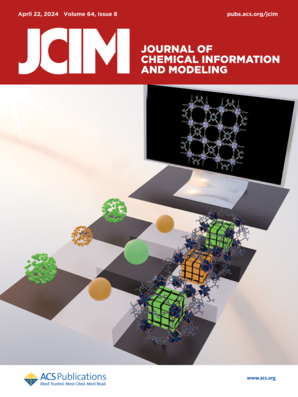Ramachandran-like Conformational Space for DNA
IF 5.6
2区 化学
Q1 CHEMISTRY, MEDICINAL
引用次数: 0
Abstract
DNA’s ability to exist in a wide variety of structural forms, subforms, and secondary motifs is fundamental to numerous biological processes and has driven the development of biotechnological applications. Major determinants of DNA flexibility are the multiple torsional degrees of freedom around the phosphodiester backbone. This high complexity can be rationalized by using two pseudotorsional angles linking atoms P and C4′, from which Ramachandran-like plots can be built. In this contribution, we explore the distribution of η (eta: C4′i–1-Pi-C4′i-Pi+1) and θ (theta: Pi-C4′i-Pi+1-C4′i+1) angles in known experimental structures retrieved from the Protein Data Bank (PDB), subdividing the conformational space into different datasets. After the removal of the canonical/helical conformations typical of the B-form, we find the existence of a conformational map with clearly permitted and forbidden regions. Some of these regions are populated with specific DNA forms, like Z- or A-DNA, or by specific secondary motifs, like G-quadruplexes and junctions. We evaluated the sequence dependency and energy relationship among the high-density regions identified in the η–θ space. Furthermore, we analyzed the effect produced by proteins and cations when bound to DNA, finding that specific proteins produce some nonhelical conformations, while other regions appear to be stabilized by divalent cations.

DNA 的拉马钱德兰式构象空间
DNA 能够以各种结构形式、亚形式和次级图案存在,这对许多生物过程至关重要,并推动了生物技术应用的发展。DNA 灵活性的主要决定因素是围绕磷酸二酯骨架的多个扭转自由度。利用连接原子 P 和 C4′ 的两个假扭角可以合理解释这种高度复杂性,并由此建立类似拉马钱德兰的图谱。在本文中,我们探讨了从蛋白质数据库(PDB)检索到的已知实验结构中的η角(eta:C4′i-1-Pi-C4′i-Pi+1)和θ角(θ:Pi-C4′i-Pi+1-C4′i+1)的分布,将构象空间细分为不同的数据集。在去除典型的 B 型典型/螺旋构象后,我们发现构象图中存在明显的允许区域和禁止区域。其中一些区域存在特定的 DNA 形式,如 Z 型或 A 型 DNA,或特定的次级图案,如 G 型四联体和连接。我们评估了在η-θ空间中发现的高密度区域之间的序列依赖性和能量关系。此外,我们还分析了蛋白质和阳离子与 DNA 结合时产生的影响,发现特定蛋白质会产生一些非螺旋构象,而其他区域似乎会被二价阳离子稳定。
本文章由计算机程序翻译,如有差异,请以英文原文为准。
求助全文
约1分钟内获得全文
求助全文
来源期刊
CiteScore
9.80
自引率
10.70%
发文量
529
审稿时长
1.4 months
期刊介绍:
The Journal of Chemical Information and Modeling publishes papers reporting new methodology and/or important applications in the fields of chemical informatics and molecular modeling. Specific topics include the representation and computer-based searching of chemical databases, molecular modeling, computer-aided molecular design of new materials, catalysts, or ligands, development of new computational methods or efficient algorithms for chemical software, and biopharmaceutical chemistry including analyses of biological activity and other issues related to drug discovery.
Astute chemists, computer scientists, and information specialists look to this monthly’s insightful research studies, programming innovations, and software reviews to keep current with advances in this integral, multidisciplinary field.
As a subscriber you’ll stay abreast of database search systems, use of graph theory in chemical problems, substructure search systems, pattern recognition and clustering, analysis of chemical and physical data, molecular modeling, graphics and natural language interfaces, bibliometric and citation analysis, and synthesis design and reactions databases.

 求助内容:
求助内容: 应助结果提醒方式:
应助结果提醒方式:


